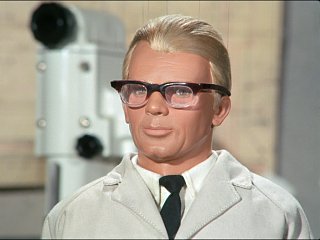 DESCRIPTION
DESCRIPTION
| NAME: | Ian McClaine |
| AGE: | 48 |
| BORN: | Baron's Court, London 24th June |
| POSITION: | Electronics Engineer |
| HEIGHT: | 5' 10" |
| HAIR: | Blonde |
| EYES: | Brown |
At the age of 48, Ian McClaine, an electronics engineer, has become one of the scientific geniuses of the twentieth century. His brains, his know-how and his invention of the BIG RAT have helped to keep the present world politically stable, and through him world peace has been stimulated. He is a quiet, stubborn and determined man.
Born in Baron’s Court, London, Ian McClaine was the son of a physicist, employed by the British Government Research Department. His mother was a famous novelist. Date of birth 24th June (series is placed 30 years hence).
Mac’s early life was spent in the country while his father was commissioned to the top secret research development station in Dorset. It was a favourable move for the members of the McClaine family, giving his mother peaceful surroundings to concentrate on her writing, and giving Mac the dream environment of every young boy: tumbling sands, green fields and the magnetic sea, so very different to the city life he’d been used to.
It was during his early boyhood that Mac developed a love for the county of Dorset, and all it stood for, he vowed that wherever life led him in the future, he would always return to the place that had meant so much to him.
The young Ian McClaine revelled in the sunshine. His greatest love being fishing, he spent endless hours at sea in his father’s yacht, lazing away his time with a fishing rod. But all this was soon to end, for at the tender age of nine, Mac was sent to Canford Magnor, one of Britain’s leading public schools, in the hope that a good education would bring Mac to emulate his father’s career.
Ian McClaine thoroughly enjoyed his school days. He excelled on the academic front, concentrating his studies on physics, aerodynamics and electronics. In the sports, too, he was tops. By the end of his nine year stay at the school, Mac had attained distinctive honours in his three chosen subjects. He was given a scholarship to Cambridge, an exceptional credit to his ageing parents.
Mac graduated to Cambridge University to study electronics and aerodynamics. And it was here that Mac first discovered his flair for ballooning. It was during Mac’s second year at the newly-founded St Lucifer’s college that Mac attended an optional lecture on the art of ballooning. He loved every second of it. After the talk, he trapped the lecturer in endless conversation on the possibilities of piloting balloons in the present day.
The next day, Mac decided to try out the lecturer’s theory. Summoning all his financial resources he managed to buy the raw materials used in the construction of a balloon and he set out to design, and ultimately build, his own balloon with the intention of flying it. It took him just three days to formulate a prototype model and then construct the real thing.
Having gained permission to use the University’s store of helium gas, Mac put into operation his first attempt to fly his balloon. A large crowd had gathered to see a feeble attempt. But Mac astounded them. The balloon rose into the air, and with the aid of directional navigation, a unique series of equipment designed by himself, Ian McClaine piloted the balloon around the perimeter of the city and landed on the University’s playing fields to a hero’s welcome. This was the first spark that made Mac give up three years of his later years to design and build balloons. But it was also the spark that was to almost cost him his life not three years later.
Apart from this act of extroversion, Mac settled down to a normal existence at Cambridge. He studied hard and had excellent results in his yearly examinations. In his last year at University, Mac relinquished all his non-academic interests to concentrate on his studies with the hope of gaining an advanced scholarship to the United States at Stanford University. Mac’s hopes were realised on graduation day, when he received great commendation for his excellent academic results in electronics and aerodynamics. He was granted that elusive ticket to Stanford.
But the scholarship had its drawbacks. It was a grant to be used a year hence, meaning that Mac had to "kill" time - kill a year of his life somehow. He decided that his love for balloons should be activated, so he enrolled at the Aerodynamic Academy in London to study ballooning, under the watchful eye of the lecturer who had made the sport so real to him while at Cambridge.
In the short 12 month spell, Mac, with the help of fellow students, piloted his balloon on dare-devil journeys around the globe. In doing this he carved a name for himself in the annals of history. He crossed the Alps from Switzerland to Italy; flew a balloon along the full length of the Mississippi; and circumnavigated the continent of Australia. All in 12 months, and all by balloon.
But amid the triumph and success, Mac had his set backs, for on the eve of his accession to Stanford, his parents were both killed in an explosion at the family home, when Mac’s father was experimenting with dangerous chemicals.
Mac moved from Britain to America and a three year course at Stanford. And it was here that the Englishman met a man destined to be his life-long friend - Sam Loover. Mac and Sam Loover studied electronics together, they followed the same pastimes together, and were virtually inseparable - a friendship that was stimulated a year later when Sam saved Mac’s life after a ballooning accident in the Arizona desert.
Life at Stanford came naturally to both Loover and McClaine. Both graduated from the academy with degrees in electronics. Sam moved into government research, while Ian McClaine left for England with an undecided mind about how he wanted to employ his talents.
At the age of 24, Mac returned to England, to London and the Aerodynamic Academy to study further developments in ballooning. For three years he studied, putting forward new ideas, going on new safaris with his balloon and conquering many heights. His achievements were headline news.
During Mac’s three years of indecision with regard to a chosen profession, he met a woman at the academy with the same ideals as himself - Mary Reed - who was later to become Mary McClaine. Together these two worked to design, build and pilot balloons across the face of the globe.
Three years passed, and McClaine was offered a job as electronics controller of a private industrial firm dealing with computers. He accepted the job and stayed with the firm for eight years, graduating from electronics controller to general manager of the company, and the firm thrived on numerous inventions made by this master mind.
Mac was now 36, and had yet again come to a milestone of indecision in his career, so he decided to put his inheritance to its best uses. He bought a tiny, picturesque cottage near the sea in his childhood home of Dorset. His intention was to convert the old sea tunnels running under the cottage into a luxury research laboratory. He intended to devote his life continuing his father’s research into advanced computerisation of brain patterns.
Mac contracted a building firm to build his underground laboratory, sparing no expense. But the building of the wonder-lab took time, so Mac decided to take a flat in the heart of London and write, so that his knowledge could be passed on to the world. The first book he published was not on electronics but on ballooning - signs of a divided love. Fate then played a great part in Professor McClaine’s life. He decided that he needed a secretary to help with the backlog of unfinished manuscripts. He advertised the position, and a long lost friend - Mary Reed - applied for the job, accepted, and three months later was married to the sandy-haired scientist.
By now the world knew the name Ian McClaine. His books on ballooning and electronic aerodynamics were best-sellers. He appeared on television, and everywhere he went he was given celebrity treatment. Then, suddenly, the professor faded from the public eye. His dream cottage was complete, and he moved underground to turn his dreams into wonder equipment, to live the life of a seemingly eccentric scientist. But Mac was a scientist who knew just what had to be done and how to do it.
The cottage is a wonderful combination of the old and the new - labour saving devices for housework etc. although these are not used by Mrs Harris.
For eight years, the McClaines lived in the country retreat. Mac worked on his experiments and wrote occasional books, and Mary acted as a normal secretary-housewife. It was during these intense but leisurely days that Professor McClaine designed and built his wonder car, a car that could travel on land, in the air and on water, a car built for the performance of its unique tasks as opposed to a sleek, slimline pleasure model, for the Professor did not appreciate fine frills. It was this car that was to bring him together with Joe, the boy he was later to call ‘son’.
One morning, Mac was summoned to London by his publishers, to discuss a new book on Mac’s experimental achievements. The Professor parked his car outside the publishing house in Fleet Street and went inside for the discussion. A few minutes later, a party of children from the nearby orphanage passed on a sight-seeing visit to the newspaper centre of the world. Fascinated by the parked car, a small fair-haired boy divorced himself from the main party, intent on looking into the car. But he didn’t stop at looking. The boy climbed inside the cab for further investigation. Minutes later, McClaine came out of the publishing house, got into his car and drove off, carrying the stowaway huddled behind the seat.
Arriving home, Mac was amazed when Joe revealed himself. In fact, the Professor was aghast. He didn’t know what to do. But he invited Joe in for tea and showed him around the laboratory, demonstrating experiments all afternoon. Joe loved every minute of it. Though only five years old, he revelled in the whole set-up. Soon it was time to return Joe to the orphanage, and Joe was extremely reluctant to part company with his new-found friends, the McClaines. With a pledge to visit Joe in the orphanage and let the boy visit the cottage, Joe finally agreed to be taken home and Mac drove back into London with his cargo.
Joe’s friendship with the McClaines increased and they decided then that would take him away from the home to live with them as a family: give him a real family upbringing. So Mac and Mary decided to adopt Joe. The adoption procedure was long, but within six months, Joe McClaine quickly adapted to his role at Culver Bay. Joe was devoted to his parents and indeed, his inquisitive presence stimulated Mac’s powers of experiment.
For a full year, the McClaine family lived happily. Joe was sent to the local school while Mac carried on with his new experiments in brain pattern transference. But the happiness of the year was to end abruptly when, in the autumn, Mary McClaine was killed on a visit to Mac’s publishers in London. Her car crashed at high speed on the Dorset to London motorway. It was a crippling blow to both Mac and his six year old adopted son and Mac, ridden with grief, shut himself away in his laboratory to spend endless hours on his newest invention.
But, spurred on by the completion of his wonder machine and his new responsibility towards Joe, Ian McClaine completed his task of building a super brain pattern transplant machine - the BIG RAT. It took him three years to achieve what many critics had called impossible and BIG RAT was at last born, born into the service of world peace. For Professor McClaine it was a dream come true. And for Joe, the start of a whole series of adventures that neither father nor son had envisaged.
Biographical details taken from the Joe 90 "writers' guide", written by series script editor Tony Barwick and scriptwriter Shane Rimmer based on the format and characters developed by Gerry & Sylvia Anderson.
| The puppet of Ian McClaine was created especially for the series by Puppet Co-ordinator Mary Turner, and did not go on to make any appearances in The Secret Service. Four expressions were created: 'normal', 'frowner', 'smiler' and 'blinker', but the subtlety was often lost once Mac's trademark glasses were in place. |
 |


